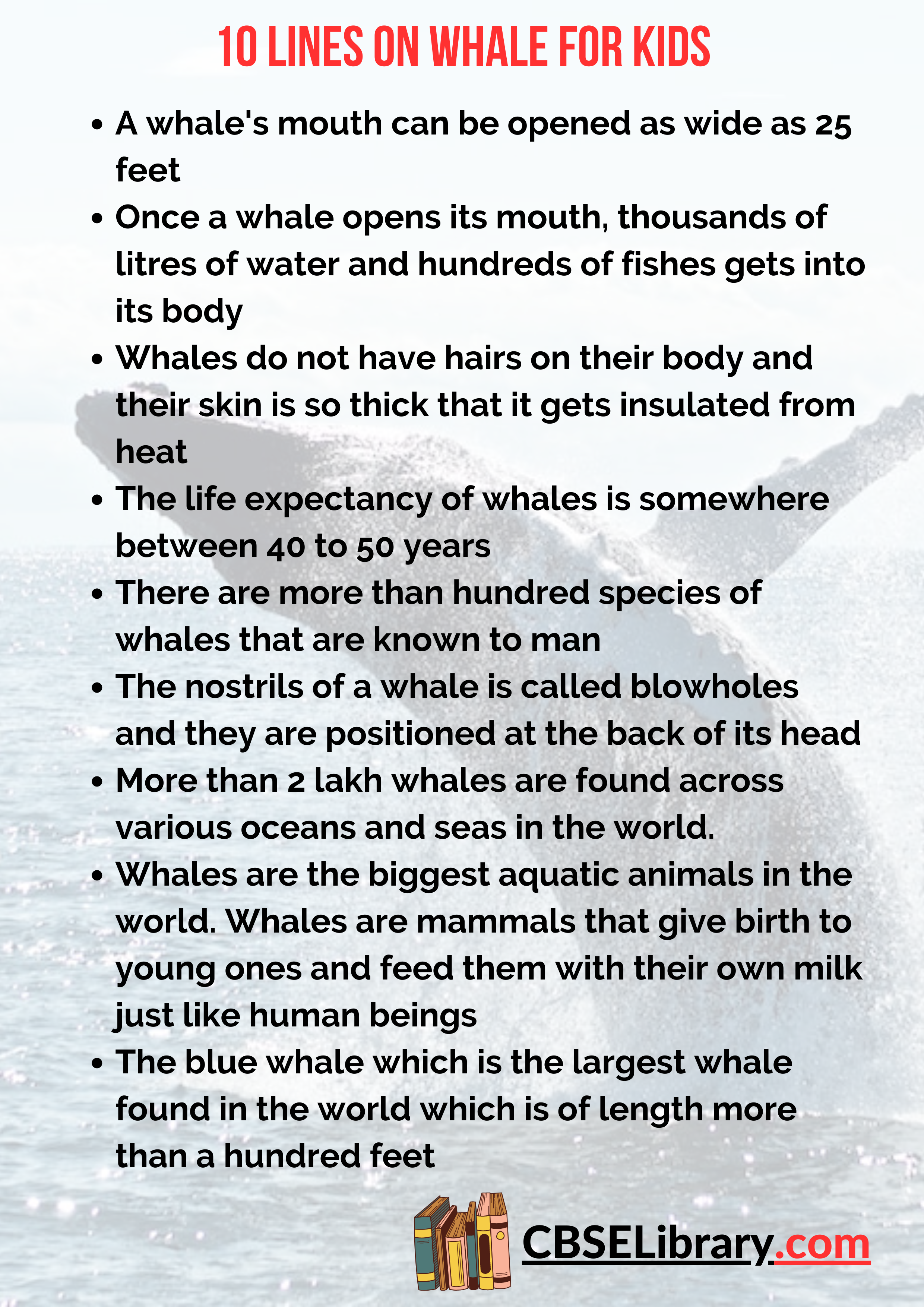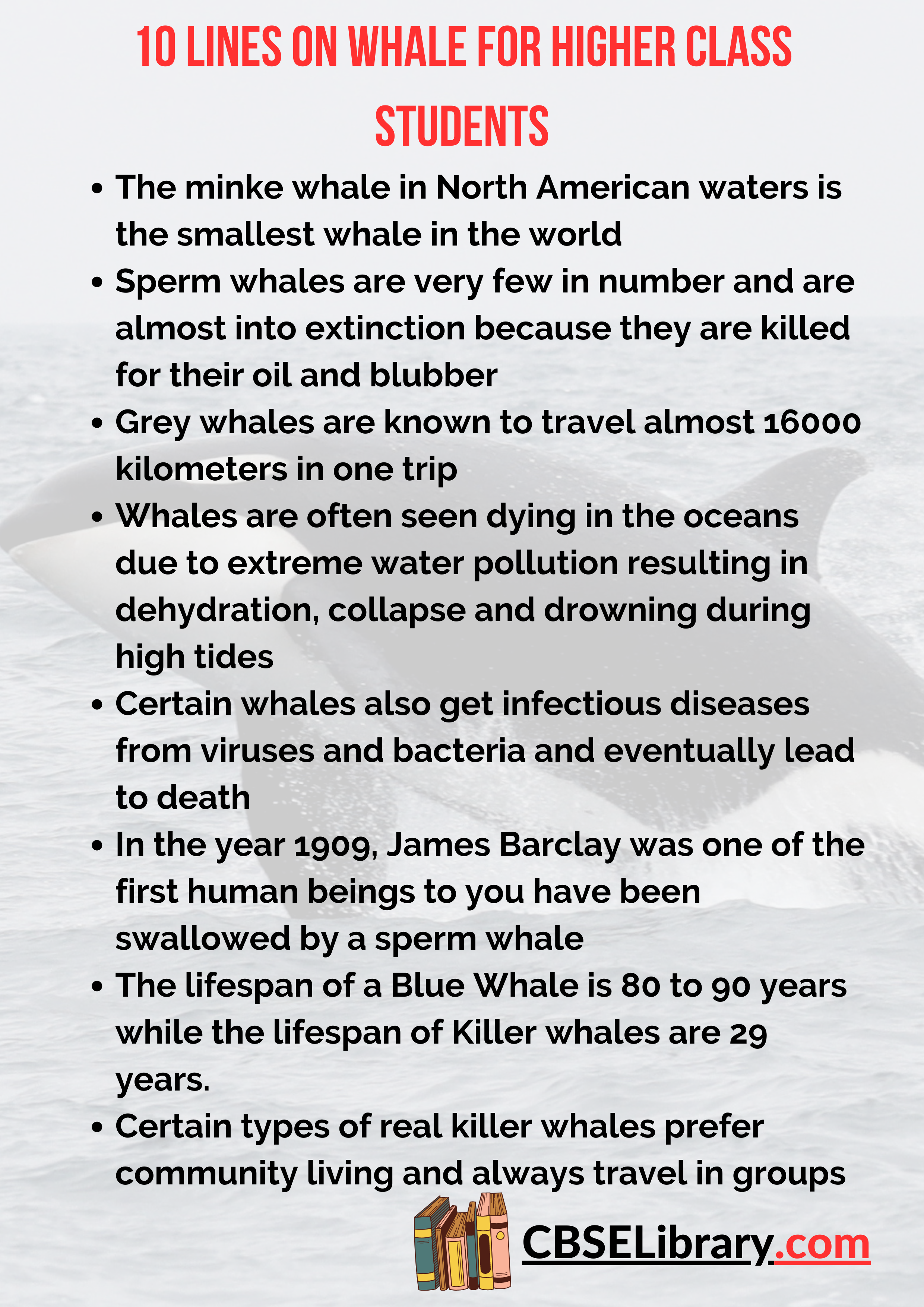10 Lines on Whale: Whales are the biggest aquatic animals in the world and most of us have usually watched it in videos and pictures but never in real life. They are found in remote areas of seas and oceans and are important to maintaining the ocean ecology. Whales are usually not considered as fishes but they are considered as some of the largest mammals to have walked on this planet. The blue whale is the biggest of them whose length is more than a hundred feet.
In this particular 10 lines on whales in English article, we shall be talking about various aspects of whales such as what does a whale eat, how does a whale look, where are whales found, what is the lifespan of a whale and many more such questions will be answered.
You can read more 10 Lines about articles, events, people, sports, technology many more.
Set 1 – 10 Lines on Whale for Kids
Set 1 is helpful for students of Classes 1, 2, 3, 4 and 5.
- Whales are the biggest aquatic animals in the world. Whales are mammals that give birth to young ones and feed them with their own milk just like human beings
- The blue whale which is the largest whale found in the world which is of length more than a hundred feet
- A whale’s mouth can be opened as wide as 25 feet
- Once a whale opens its mouth, thousands of litres of water and hundreds of fishes gets into its body
- Whales do not have hairs on their body and their skin is so thick that it gets insulated from heat
- The life expectancy of whales is somewhere between 40 to 50 years
- There are more than hundred species of whales that are known to man
- Whales are carnivorous animals and eat small fishes, phytoplanktons and other sea animals
- The nostrils of a whale is called blowholes and they are positioned at the back of its head
- More than 2 lakh whales are found across various oceans and seas in the world.

Set 2 – 10 Lines on Whale for School Students
Set 2 is helpful for students of Classes 6, 7 and 8.
- Whales come out of the water every 35 minutes to take a breath. Sometimes whales just lift their head and just part of out of the water for fun and this phenomenon is called by scientists as spy-hopping
- Sperm whales are some of the largest toothed whales and also the largest toothed predators found on the planet
- Sperm whales are known to eat human beings that are found on ships, boats and oceanic islands
- Sperm whales exhibit extremely loud high pitched noise whose decibels are as high as 174
- Blue whales are the loudest mammals on the planet whose voice can reach as high as 188 decibels
- The low frequency of the pulses of blue whales can be heard as far as 850 kilometres from the source
- The weight of a whale ranges between 800 to 1600 kgs
- There are more than 90 species of whales that are found in the world
- Whales are warm-blooded creatures and they have many medicinal values for human beings
- Whales are important to maintain the industrial revolution because the oil that comes from them are used in many factories for the manufacturing of goods
Set 3 – 10 Lines on Whale for Higher Class Students
Set 3 is helpful for students of Classes 9, 10, 11, 12 and Competitive Exams.
- Certain whales such as humpback whales that are found in the United States of America can sing complex songs with high pitched decibels
- The weight of a Blue Whale is equal to almost twenty-three elephants that is 150000 kgs
- Certain types of real killer whales prefer community living and always travel in groups
- The minke whale in North American waters is the smallest whale in the world
- Sperm whales are very few in number and are almost into extinction because they are killed for their oil and blubber
- Grey whales are known to travel almost 16000 kilometers in one trip
- Whales are often seen dying in the oceans due to extreme water pollution resulting in dehydration, collapse and drowning during high tides
- Certain whales also get infectious diseases from viruses and bacteria and eventually lead to death
- In the year 1909, James Barclay was one of the first human beings to you have been swallowed by a sperm whale
- The lifespan of a Blue Whale is 80 to 90 years while the lifespan of Killer whales are 29 years.

FAQ’s on 10 Lines on Whale in English
Question 1.
What is the lifespan of a wale?
Answer:
Depending upon the type of the whale, the lifespan varies between 30 years to 100 years
Question 2.
What is the average length of a Blue Whale?
Answer:
The average length of the blue whale is between 24 to 28 meters
Question 3.
How many whales are there in the world?
Answer:
More than 15000 whales are estimated to be present in the world
Question 4.
How do whales reproduce?
Answer:
Blue whales reproduce through sexual reproduction which is also known as sexual meiosis where the male’ sperm and female’s eggs combine and fertilize in the female whale’s body
